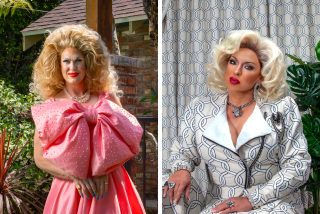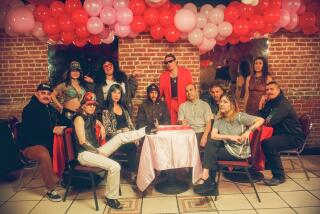So many ways for them to say L.A.
Linda LACK, Hae Kyung Lee and Bradley Michaud have very different ideas about dance making. Just consider what they require to collectively put on a show.
Lack needs a 9-foot lizard sculpture and various animal masks. Michaud and his dancers will not hurl themselves into the air without their kneepads. Lee, meanwhile, simply brings the inspiration she derives from her spiritual life and Korean heritage.
Aesthetic, generational and cultural diversity will definitely be on display, in short, when these three choreographers take the stage at California Plaza on Sept. 8 in a program called “Modern Los Angeles Dances.” Conceptually speaking, the show, sponsored by the summer series Grand Performances, aims to advance the proposition that contemporary dance at the local level is not only alive and well but healthily heterogeneous.
“We wanted it to be a fresh look at what our city has to offer,” says Leigh Ann Hahn, director of programming for Grand Performances. “We see this show as an interesting mixture.”
Now in its 21st season and ever popular for its free concerts and visually striking outdoor venue, Grand Performances has a long-standing commitment to presenting dance from both abroad and its own backyard. In recent years, for example, Chinese choreographer Willy Tsao has brought several companies to California Plaza’s Watercourt, just as local companies such as Diavolo Dance Theater have continued to be invited back.
With its two stages and majestic fountain, the plaza has also served as inspiration for a number of site-specific works by such L.A.-based choreographers as Oguri, Heidi Duckler and Lee, who in 2000 created a piece called “Ancient Mariners” that had her dancers jumping into the fountain, navigating a boat and performing a kind of water ballet in the adjacent pool with fake fish dangling from their mouths.
“It’s very important for me to support not only dance in general but dance in L.A.” says Michael Alexander, Grand Performances’ executive director. “Dance is the most challenged art form of all the art forms in Los Angeles, and I am committed to finding different ways to present it.”
A childhood friend of Lack’s, Alexander has always followed her career, which has included performances mostly outside L.A., and wanted to give her the opportunity to appear locally. As for Lee, “we thought she would bring a different cultural voice to the program,” Hahn says. “We also wanted a male, more emerging voice, and we thought Bradley would be a good complement.”
All their works will take place Sept. 8 on a dancer-friendly platform specifically constructed to fit the dimensions of the concrete Marina Pavilion, the smaller of California Plaza’s two stages. Most of the props will belong to Lack, whose four solo dances involve demon and wolf masks, the aforementioned lizard, a number of rubber skulls and other eye-catching items.
The creator of a yoga-based technique called “The Thinking Body -- The Feeling Mind,” Lack presents what she calls “masked dance rituals.” By wearing masks, the sixtysomething choreographer feels, she can achieve a distinct theatricality and make politically charged artistic statements in ways that wouldn’t work if she were “simply Linda Lack.”
“I don’t make dances unless I have something to say, but there is something about a mask that makes my work more universal,” she says. “The masks I wear represent characters that I believe belong to every human being.”
In her solo “Mea Culpa,” for example, Lack wears a red demon mask that allows her to express her take on contemporary greed, lust, violence and apathy. “This is a terrible piece for me to perform,” she says. “But when I put a mask on, the creature it represents dictates what I do.”
At a recent informal showing of her solos at her La Cienega Boulevard studio, Lack demonstrated the energy and suppleness of a woman decades younger as she contorted, inverted, wriggled, slid and performed a number of other animalistic movements that clearly reflected her years of yoga practice.
“Had I not developed my own technique, it wouldn’t be humanly possible for me to perform today,” she observes. As a young dancer in New York, she did “pickup” work for Twyla Tharp, and she says, “Even then, I had an awareness that I didn’t want to be abusive as a dancer, to move in ways that one day would mean I’d lose a hip.”
A niece of modern dance pioneer Pearl Lang, Lack grew up in Los Angeles and early on became fascinated with movement, performance and masquerade.
“When I was 10, I won a prize at a Halloween carnival for making this mask of a creature that had these strange antlers and eyes, while everyone else was into princesses and cowboys,” she recalls. “In Hebrew school, I transformed myself into a dreidel, and even then I think I realized I was onto something.”
As a child, Lack also traveled extensively through Mexico and Central America, and “I found myself so drawn to depictions of a culture’s concerns through masking and storytelling. I guess I felt that my culture had lost its rituals. So I wound up building my own.”
A world of experience
By contrast, the 54-year-old Lee continues to draw artistic sustenance from her own ancestry. Raised in South Korea, she immigrated to the United States at 25, received a master of fine arts degree from UCLA, studied dance in New York and Paris and embarked on a career as a solo artist before founding Hae Kyung Lee and Dancers in 1990. Her work, rooted in postmodern dance technique and often allusive to her Korean roots, has been described by critics as butoh-like, ethereal and fearless.
“My whole life is about discovery, realization and growth, and artistically I never want to repeat myself or anyone else,” she says. “When I studied Graham technique in New York, I knew I didn’t want to be Martha, I wanted to be me. And it’s the same with the dancers in my company. . . . I don’t want them to be little Haes.”
At California Plaza, Lee will perform a 10-minute solo called “Revolution” that she premiered in April at Cal State L.A.’s State Playhouse. The piece reflects her feelings of “having a new lease on life” as a woman in her 50s who’s not only choreographing but performing.
“I had given up solo work,” she says. “But I’ve realized that dancing keeps me alive. It allows me to connect spiritually in a different way than when putting my movement on other bodies.”
Lee declines to say much more about her work, however, preferring that “audiences decide for themselves what my dances are about. My work is never about storytelling or some particular conclusion. But it’s always connected to emotional states.”
The same might be said of Michaud, 29, though in his case, emotions have thus far translated into an extreme, high-speed physical vocabulary.
“When a person trips and falls, I’m most interested in the moment when the person first loses control,” he says. “Because that’s the moment when the person loses their artifice. . . . In my work, you can’t fake a fall.”
Performing at California Plaza with his five-member company, Method Contemporary Dance, Michaud will present a shortened version of “Supercedure,” which he premiered in April at the Diavolo Dance Space. “I had wanted to do a piece about what it means to work in a group and how power struggles emerge,” he says.
Drawing on his own experiences as a member of the now-disbanded Tongue dance company, his day job as a paralegal and his current role as artistic director of his own company, Michaud created a work in which each of his dancers took turns controlling the others, creating continual shifts in group dynamics.
The process of making “Supercedure,” he says, was basically a “nine-month therapy session. It was cathartic. I really like where I work, and I love my dance company. But in any group, there’s all this crap you have to contend with. Like, let’s say you’re at a meeting and someone gives you a compliment, but later, he’s talking behind your back.”
Raised in Oak Park, Calif., Michaud, not surprisingly, thrived on such pastimes as riding roller coasters and snowboarding. He also developed an early love for break dancing, trained in ballet and modern and performed in musical theater and an Irish step-dancing company. His aesthetic began to coalesce after he became a dance major at UCLA.
“I was into the speed of Irish dancing and the topsy-turviness of break dancing,” he says. “I was not into spoken word or political commentary or any multidisciplinary work. I was never the type to say, ‘Hey, I think I’m going to insert this Robert Frost poem into my dance because I think it says something.’
“I’m all for making work that has an impact,” he adds. “Just not by constructing something contrived. My process is to create situations for stuff to naturally arise.”
Lack and Lee would probably say the same of themselves. And as for what else might unite these choreographers, perhaps Lee says it best:
“With my work, I don’t have fear. I only hope that my work never grows stale.”
--
‘Modern Los Angeles Dances’
Where: Grand Performances at California Plaza, 350 S. Grand Ave., L.A.
When: 8 p.m. Sept. 8
Price: Free
Contact: (213) 687-2190 or www.grandperformances.org
More to Read
The biggest entertainment stories
Get our big stories about Hollywood, film, television, music, arts, culture and more right in your inbox as soon as they publish.
You may occasionally receive promotional content from the Los Angeles Times.










